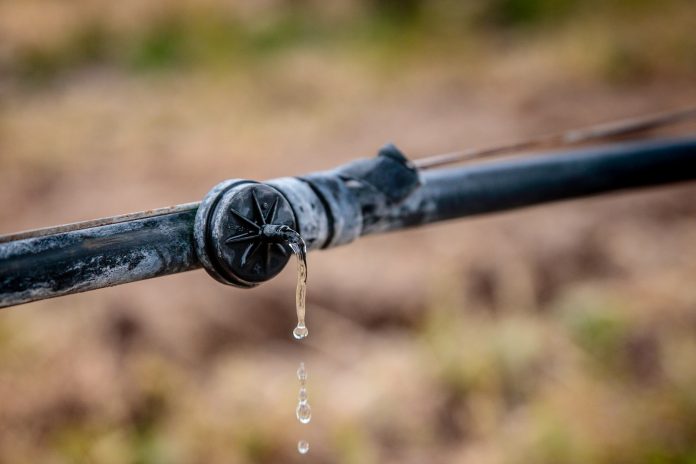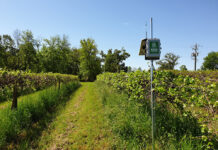Irrigation is probably the most powerful tool a winegrape grower has in their tool box. Intelligent use of irrigation can control canopy size, manage vine stress, manipulate berry size, improve wine quality and conserve water. The key to achieving a grower’s viticultural goals through irrigation is data-driven scheduling to determine when and how much to irrigate.
The tools growers have available for irrigation scheduling generally fall into five categories: soil-based, plant-based, weather-based, remote sensing and visual assessment of the vine’s water status.
Soil-Based Methods and Technologies
Soil moisture sensors are an effective way of measuring how much water is in the soil, where it is in the profile and how and when the vine is taking up that water. Another benefit of soil moisture sensors is the ability to measure the effect of winter rain on the soil profile
For the best resolution, multiple sensors are needed per block reflecting soil types and topography. The key is placing sensors in locations which are representative of larger areas. Soil maps can help identify the best locations. Ideally, a soil map was made prior to vineyard installation. Mapping can still be done after installation with the help of a professional agricultural soils expert. Identifying representative areas within a vineyard can also be done using Normalized Difference Vegetative Index (NDVI) mapping. These maps identify areas of weak or excessive vigor. Those areas should be avoided as locations for sensors.
The best depths for sensor placement can be determined by taking soil cores with a hand auger. Look for changes between soil horizons which might impact water holding capacity. Depths should represent rooting depths and just below to monitor deep percolation. Place the sensor in the vine row approximately 18 inches from the vine trunk and four to six inches from the emitter.
Types of soil moisture sensors include quantitative technologies such as time domain transmissometry, capacitance measurements, time domain reflectometry and qualitative methods such as matric potential. Each has its advantages and disadvantages in terms of cost, soil volume measured and ease of installation. No one type of sensor is ideal for all situations, so some research and ground truthing against other methods like visual assessment is required to find the best fit for your particular vineyard.
Plant-Based Methods and Technologies
Probably the most common method for evaluating vine water status is leaf or stem water potential using a device such as a pressure bomb. This method measures the tension (or “potential”) between the pull of water through the plant from evapotranspiration and how tightly water is held to the soil. A leaf is cut from the vine. The blade is placed under pressure forcing water back through the xylem of the petiole. The more pressure required to force the water out, the drier the vine is.
A porometer is another tool which directly measures an indicator of vine water status. Porometers provide a reading of how relatively open or closed the stomata are on the leaf. Stomata are open when there is water available for evapotranspiration. When stomata start to close, the vine is protecting itself from drying out—a sign of stress. A sensor is clipped to a leaf blade and a measurement is taken automatically.
An indirect measurement of stomatal closure can be done with an Infrared thermometer. Transpiration cools the surface of the leaf, making it cooler than the ambient air temperature. As stomata close, the temperature of the leaf blade increases. Readings are taken by simply pointing an infrared thermometer at the canopy. This method is simple, quick and generates good quality data that is easy to interpret when analyzed over time.
Weather-Based Methods and Technologies
While not a direct measure of vine water status, weather-based methods allow for data-informed scheduling decisions for the vineyard as a whole. By estimating how much water vines have transpired, a grower can decide how much water to put back into the soil, or not, in the case of deficit irrigation. This is done by estimating the daily water loss of the vine using evapotranspiration (ET) rates. The baseline for comparison is the reference ET, also called ETO or “full ET”. The California Irrigation Management Information System (CIMIS) maintains remote stations throughout California to provide reliable estimates of ET. Many weather stations available today also estimate ETO.
Grapevines do not transpire at the full ET rate, so a crop coefficient (KC) is required to better reflect how the vine is behaving under these conditions. Essentially, the more canopy, the more water is transpired by the vine. As canopy size varies during the course of the growing season, the ratio of water transpired by the vine to reference ET changes. Therefore, the crop coefficient needs to be calculated at multiple times during the season. Calculating the crop ET (ETC) uses the equation ETO × KC = ETC.
KC is determined by measuring the percent of the vineyard floor shaded at solar noon. This can be done with a gridded board to estimate the width of the shade and the percent of gaps in the shaded area. The percentage of shaded floor area is then used in the following equation to calculate the crop coefficient: KC = Percent shaded area × 0.017
Using ETC is especially helpful for successful deficit irrigation. A crop coefficient for deficit irrigations, called KRDI, can be calculated by multiplying KC by the percent deficit desired using the equation KC × %RDI target = KRDI. This gives the grower confidence that they are hitting their specific target for deficit irrigation taking current weather conditions into account.
An example:
The percent of vineyard floor shaded is 25%.
This gives a KC of 0.425.
If the RDI target is 75% the KRDI is 0.319.
If the ETO rate for the week is two inches, 0.638 acre-inches should be applied to maintain vines at their current water status.
Remote Sensing
Remote sensing using the Normalized Difference Vegetative Index (NDVI) is a powerful tool as it provides a literal picture of vine vigor across a large area to a high degree of resolution. Maps are created by flying over the vineyard with a drone or fixed wing aircraft. Cameras on the aircraft record the amounts of near infrared and red wave lengths reflected by the vineyard canopy. NDVI is calculated using an equation that compares these wavelengths. The resulting numbers correlate to the relative photosynthetic activity of the canopy which is directly tied to vine water status.
Visual Assessment
Purely qualitative practices for assessing vine water status are commonly used by growers. One can simply look at the appearance of vines searching for tell-tale signs of stress without the need for any devices. This is an excellent way of ground truthing other methods.
Vine response to stress can readily be seen in the growth pattern of shoots and angle of leaf blades. When tendrils extend far beyond the shoot tip, the vine is growing rapidly and is under no stress. As the soil and vine begin to dry out, tendrils become shorter.
Shoot tips are another good indicator. The state of a shoot tip can be determined by folding the last fully opened leaf up toward the tip. If the shoot tip extends past the leaves, it is active. If the folded leaves cover the shoot tip, it has stopped growing. Eventually, the tip will die altogether.
Leaves provide another clue to vine stress. Under stress, leaves begin to droop. Leaves on an unstressed vine will form an obtuse angle to the petiole. As stress progresses, this angle becomes less and less until it is acute.
Using visual inspection of the vine successfully requires many years of experience to perfect. Combining experience with quantifying technology may give the grower more confidence that their “read” of the vines is correct. One serious drawback of relying solely on looking at vines for indicators of stress is that there is a delay between the onset of stress and the symptoms becoming apparent in the state of the canopy. Overshooting a stress goal under RDI can be difficult to recover from, especially during late season.
Consider using a combination of at least two different types of irrigation scheduling methods as each measures different variables and provides a different viewpoint of what is happening in the field. The vine’s response to irrigation depends on soil physics, changes in weather patterns year to year, vine age, crop load, canopy size and disease status. Taking all those variables into account is challenging even with the best tools. The more tools in the tool box, the better equipped the grower is to harness the power of well scheduled irrigation.



















